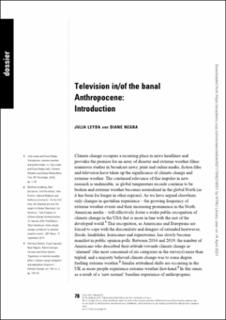| dc.contributor.author | Leyda, Julia | |
| dc.contributor.author | Negra, Diane | |
| dc.date.accessioned | 2021-04-14T12:17:40Z | |
| dc.date.available | 2021-04-14T12:17:40Z | |
| dc.date.created | 2020-11-30T13:29:14Z | |
| dc.date.issued | 2021 | |
| dc.identifier.citation | Screen. 2021, 62 (1), . | en_US |
| dc.identifier.issn | 0036-9543 | |
| dc.identifier.uri | https://hdl.handle.net/11250/2737746 | |
| dc.description.abstract | Climate change occupies a recurring place in news headlines and provides the premise for an array of disaster and extreme weather films; numerous studies in broadcast news, print and online media, fiction film and television have taken up the significance of climate change and extreme weather. The continued relevance of this impulse in new research is undeniable, as global temperature records continue to be broken and extreme weather becomes normalized in the global North (as it has been for longer in other regions). As we have argued elsewhere, only changes in quotidian experience – the growing frequency of extreme weather events and their increasing prominence in the North American media – will effectively foster a wider public recognition of climate change in the USA that is more in line with the rest of the developed world.1 This recognition, as Americans and Europeans are forced to cope with the discomforts and dangers of extended heatwaves, floods, landslides, hurricanes and superstorms, has slowly become manifest in public opinion polls. Between 2014 and 2019, the number of Americans who described their attitude towards climate change as ‘alarmed’ (the most concerned of six categories in the surveys) more than tripled, and a majority believed climate change was to some degree fuelling extreme weather.2 Similar attitudinal shifts are occurring in the UK as more people experience extreme weather first-hand.3 In this sense, as a result of a ‘new normal’ baseline experience of anthropogenic climate change, extreme weather is becoming more and more banal, a part of everyday life for growing numbers of people. | en_US |
| dc.language.iso | eng | en_US |
| dc.publisher | Oxford Academic | en_US |
| dc.rights | Navngivelse 4.0 Internasjonal | * |
| dc.rights.uri | http://creativecommons.org/licenses/by/4.0/deed.no | * |
| dc.subject | Environmental Humanities | en_US |
| dc.subject | Environmental Humanities | en_US |
| dc.subject | Television | en_US |
| dc.subject | Television Studies | en_US |
| dc.subject | Anthropocene | en_US |
| dc.subject | Anthropocene | en_US |
| dc.title | Contemporary Television in/of the Banal Anthropocene | en_US |
| dc.type | Peer reviewed | en_US |
| dc.type | Journal article | en_US |
| dc.description.version | publishedVersion | en_US |
| dc.subject.nsi | VDP::Humaniora: 000 | en_US |
| dc.subject.nsi | VDP::Humanities: 000 | en_US |
| dc.source.volume | 62 | en_US |
| dc.source.journal | Screen | en_US |
| dc.source.issue | 1 | en_US |
| dc.identifier.doi | https://doi.org/10.1093/screen/hjab006 | |
| dc.identifier.cristin | 1854154 | |
| dc.description.localcode | © The Author(s) 2021. Published by Oxford University Press on behalf of Screen. This is an Open Access article distributed under the terms of the Creative Commons Attribution License (http://creativecommons.org/licenses/by/4.0/), which permits unrestricted reuse, distribution, and reproduction in any medium, provided the original work is properly cited. | en_US |
| cristin.ispublished | true | |
| cristin.fulltext | preprint | |
| cristin.qualitycode | 2 | |

